|
Houdini Memorabilia Makes Magic
By Mike McLeod
This past Halloween was the
75th anniversary of the death of the master magician, Harry Houdini.
The day before, Swann Auction Galleries (www.swanngalleries.com) of
New York, conducted a "Sale of Magic" auction featuring the Doug
Edwards Houdini Collection. Of the 231 lots offered, 193 sold for a
total of $260,625. Leading the list at $17,250 was Houdini's book,
Miracle Mongers and Their Methods, signed to his brother, Dash.
Houdini's leather wallet hammered at $8,625, and the cloth pocket
from the pajama top worn by Houdini (embroidered "HH") after
entering the Detroit hospital where he died sold for
$3,910.
Contrary to some beliefs,
Harry Houdini did not die in his famous "Water Torture" trick as
portrayed by Tony Curtis in the 1953 movie, but from peritonitis
from a ruptured appendix. Newspaper accounts of the day blame a
college student for his death. The student challenged Houdini's
claim to being able to withstand punches to the stomach without
pain. The student powerfully jabbed him two or three times before
Houdini prepared himself by tensing his abdominal muscles. Houdini
mentioned that he only felt a little pain after the incident, and
then he went on to complete two more performances that evening.
Later that night and the next day he complained of intense
pain.
The Houdini Historical
Center (www.houdinihistory.org) casts doubt on the student's
culpability: "Whether or not the blow ruptured his appendix, it did
not cause the appendicitis, which is a bacterial infection. Houdini
met his untimely death on October 31, 1926."
Although Harry Houdini
claimed in his own writing to be born in Appleton, Wisconsin,
documents show his birthplace as Budapest, Hungary, on March 24,
1874. His parents brought their son, Ehrich Weiss, to America at age
4. Houdini began his magical career as Eric the Great. Later, he
changed his name to Houdini after reading The Memoirs of
Robert-Houdin, a great magician of his day.
Houdini was heralded in
America and Europe as the "King of the Handcuffs" because of his
uncanny ability to escape from them. Houdini developed this talent
while serving as an apprentice locksmith. In an autobiographical
article written in London, 1910, Houdini explained this
career-changing event.
"One day whilst working as
an apprentice in a locksmith's close by the police station, one of
the young bloods of the town was arrested for some trivial offense.
He tried to open his handcuffs with some keys he had on his person,
and in the attempt broke off one of the keys in the lock. He was
brought to the shop to have the cuff opened or cut off his wrist,
and this incident, trivial as it may seem, changed my entire
career.
"While the master locksmith
was trying to open the handcuff, the whistle blew for the dinner
hour. Being a loyal union man, and incidentally, perhaps, having a
sharpened appetite, he called me to his side and said, 'Harry, get a
hack-saw and cut off this handcuff,' and then went out with the
police officer to dine.
"I tried to cut off the
cuff, but the steel was too hard, and after breaking half-a-dozen
saw-blades, the thought struck me to attempt to pick the lock. I
succeeded in doing it, and the very manner in which I then picked
the lock of the handcuff contained the basic principle which I
employed in opening handcuffs all over the world. Not with a
duplicate key, which seems to have been the only way others had of
duplicating my performance."
Houdini was also famous for
escaping from straitjackets. After mastering the trick, Houdini
found audiences unimpressed when he performed it. This led Houdini
to add suspense and danger to his performances, such as escaping
from a straitjacket while hanging suspended over a city street or a
river.
Another of Houdini's
suspenseful escapes was from a locked, metal milk can. After being
handcuffed, Houdini inserted his 5'5" frame into a milk can
measuring less than three feet high. To add suspense, Houdini had
milk or water poured in to fill the can. He later explained that he
quickly escaped from his fetters while in the can, but he purposely
waited and killed time just to add suspense.
Houdini was also a master
of the publicity stunt. In 1906, he boasted that he could escape
from the Washington, D.C. jail (which had held Charles Guiteau, the
assassin of President Garfield). After accepting the challenge, the
warden was quite out of sorts when Houdini not only escaped in 21
minutes, but he also released eight other prisoners and moved them
to other cells.
As a performance artist, it
was almost natural that Harry Houdini gravitated toward that
innovative new medium of his day-movies. He acted, directed and
produced movies and created his own studio. At the Swann auction, an
engraved stock certificate for five shares of the Houdini Picture
Corporation sold for $4,370. This stock is quite rare. Houdini acted
in Terror Island, The Grim Game, The Man from Beyond, and The Master
Mystery, a serialized tale from the screenwriters of The Perils of
Pauline, Arthur B. Reeve and Charles A. Logue.
Today, pre-1910 Houdini
memorabilia is rare and most sought after by collectors because even
though he was famous by 1910, Houdini had not reached legendary
status yet. Also, a large part of his effects resides in
institutions today. Houdini directed one of his brothers, Theo, to
burn his papers and his equipment after his death. However, Theo did
not comply, and many of his papers and personal effects are in the
possession of the Houdini History Center, the Library of Congress,
and other institutions.
It is estimated that
Houdini received on average 60 or more fan letters a day, and he was
diligent about answering them and signing his name. Houdini often
signed photographs, usually with just his last name and a date.
These can often sell in the $1,500 range. At the Swann auction, an
inscribed and signed photo portrait of a mature Houdini holding a
spirit trumpet realized $3,680. In November, a signed photo of a
smiling Harry Houdini sold on eBay for $2,025.
Photo post cards at the
Swann auction signed by Houdini brought handsome prices-more than
$4,000 each. Houdini's signature can also be found on playing cards,
posters, books on magic and spiritualism, letters and legal
documents. A book authored by Houdini, The Unmasking of
Robert-Houdin, brought $3,680 during the Swann auction. It was
inscribed to fellow magician Edward Rice and signed
twice.
As most know, Houdini
dedicated himself to exposing charlatans in the magic trade. On the
Library of Congress' website (www.loc.gov), a series of photos of
Houdini show how he exposed a fraud called "fingerprinting a
spirit," used by so-called mediums. An actual mold is made of a dead
person's hand, and during a sťance, "fingerprints of the deceased
would appear on a lampblacked trumpet." (In the photos, Houdini uses
his own hand to create the mold, not a dead person's.)
In his fraud-exposing book,
A Magician Among the Spirits, Houdini explained how lucrative this
deception was: "There are two cases on record where fortunes were at
stake because of this sort of fraud. In one case five hundred
thousand dollars changed hands upon the recognition of the finger
prints of a man who had died two years before."
Houdini waged a personal
battle against frauds and their tactics of spirit rapping, bell
ringing, and slate writing. He exposed the famous fakers of his day,
including the Fox Sisters, Eusapia Palladino, Anna Eva Fay, the
Davenport Brothers, and Margery, "The Boston Medium." Her trickery
almost landed her a $2,250 award (quite a sum in the early 1900s)
offered by the Scientific American for anyone who could produce a
manifestation outside the realm of science. Houdini caught her
ringing a bell with her foot and "levitating" a table with her
head.
Today, two museums
dedicated to the legendary escape artist, prestidigitator, actor,
and author Harry Houdin are located in Niagara Falls, NY, and
Scranto, PA.
Houdini
collector and sleigh-of-hand artist Doug Edwards said of the sale,
"This auction definitely goes to prove that magic collecting is
swiftly circling the globe with a force rivaling that of fine art,
and its prices aren't far behind."
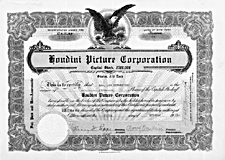
Houdini's
movie company stock, $4,370 at auction. (Courtesy Swann's
Auction)
2001
|
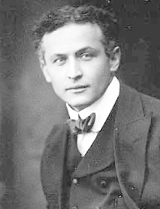
"My brain is
the key that sets me free." - Harry Houdini
(Courtesy Swann's
Auction)
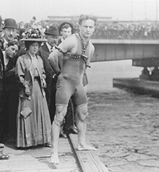
Stunts like
this manacled jump/ underwater escape from the Charles River drew
crowds...especially to his shows.
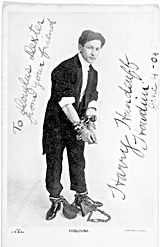
1904 photo
postcard inscribed to fellow magician, Douglas Dexter, auctioned at
$3,795.
(Courtesy Swann's Auction)
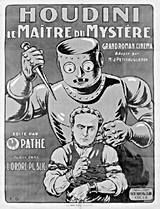
Star of
movies, including "Man of Mystery," in which he made several escapes
and defeated an evil robot. (Courtesy LOC)
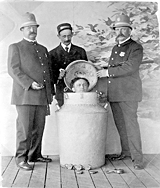
The milk can
escape - an immersed Houdini added suspense by escaping handcuffs
quickly then holding his breath a long time. (Courtesy
LOC)
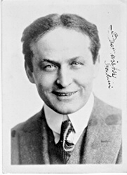
This "Smiling
Houdini" signed photo sold on eBay for $2,025.
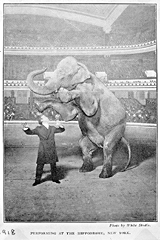
Before David
Copperfield appeared, Houdini made 10,000 lb. Jenny disappear, 1918.
(Courtesy LOC)
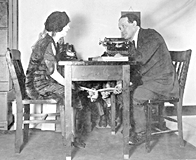
Houdini
exposing slate writing fraud. (Look under the table.) (Courtesy
LOC)
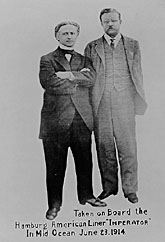
Houdini and
Teddy Roosevelt
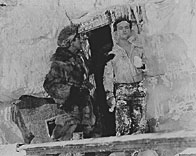
Houdini
starring in "Man From Beyond" in which he was frozen in an Artic
shipwreck, found and thawed out 100 years
later. |